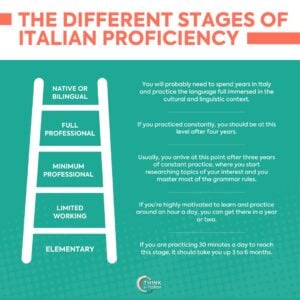Mangiare in Italy: the meals
This is probably the most important verb you need to know if you’re planning to go to Italy!
It is well known all around the world that the boot-shaped peninsula has a huge eating culture, and for a reason: mealtime is probably the most important time of the day for many Italians.
And we’re not talking just about lunch and dinner. Here’s a list of all the Italian meals you will find yourself invited to by your Italian friends:
- colazione= breakfast
In Italy, breakfast is usually sweet. It can be an espresso or a cappuccino with a cornetto (croissant), some milk and cereal, or cookies and coffee. - spuntino= light meal, nibble
You will have this a couple of hours after breakfast. - pranzo= lunch
Lunch is the first big meal of the day, many people go back home during their pausa pranzo (lunch break) to have lunch with their family. - merenda= snack (tea break in the UK)
La merenda is another light (or not so light) snack to have a few hours after lunch. - aperitivo= aperitif*
If you go out for dinner, you cannot skip the This consists of drinks accompanied by nibbles to be had before the meal. On special occasions, you can have aperitivo even before lunch! - cena= dinner, supper (also tea in the UK)
La cena is the second big meal of the day. You can have it at home with your family, or you can uscire a cena (go out for dinner). - spuntino di mezzanotte= midnight snack
If you’re feeling hungry before going to sleep, why not have a spuntino di mezzanotte?
Conjugation: the present & passato prossimo
Mangiare is a regular verb of the first conjugation and follows the typical –are pattern.
It’s a transitive verb, so it usually takes a direct object, even if it can also be followed by an adverb instead: mangiare bene or mangiare male (to eat well or poorly), mangiare in fretta (to eat in a hurry).
As we mentioned, the conjugation of mangiare follows a regular –ARE pattern:
- Io mangio = I eat
- Tu mangi = you eat
- Lui/Lei mangia = He/she eats
- Noi mangiamo = we eat
- Voi mangiate = you (plural) eat
- Loro mangiano = they eat
If you want to talk about something you ate or have eaten, you can use the passato prossimo.
To do it, just use the verb avere (to have) followed by the participio passato (past participle) of mangiare, which is mangiato.
- Io ho mangiato = I have eaten / I ate
- Tu hai mangiato = You have eaten / You ate
- Lui ha mangiato = He has eaten / He ate
- Lei ha mangiato = She has eaten / She ate
- Noi abbiamo mangiato = We have eaten / We ate
- Voi avete mangiato = You (plural) have eaten / You (plural) ate
- Loro hanno mangiato = They have eaten / They ate
Mangiare: top mistakes
Now that you have learned to use and conjugate the verb mangiare, let’s make sure you do not make the top mistakes Italian learners make with this verb!
It may seem easy enough to use, but there are some tricky details to remember!
Here they are:
It is INCORRECT to use mangiare followed by the meals we just described above, so we DO NOT SAY:
Mangiare la colazione / uno spuntino / il pranzo/ la merenda / l’aperitivo / la cena
Instead, for colazione, spuntino, merenda e aperitivo, we use the word fare (to do):
- FARE COLAZIONE
- FARE UNO SPUNTINO
- FARE MERENDA
- FARE L’APERITIVO*
You might be wondering, though, if fare colazione means to eat breakfast, what do you say when you make it, as in prepare it?
Preparare la colazione (uno spuntino, la merenda, l’aperitivo, etc.)!
To talk about lunch (pranzo) and dinner (cena), we actually have verbs:
PRANZARE = to eat/have lunch
CENARE = to eat/have dinner
Vuoi pranzare con me?
Do you want to have lunch with me?
Noi ceniamo alle 8.
We’ll have dinner at 8 pm.
*We also say BERE L’APERITIVO (to drink aperitivo), as it is mostly about drinking and not eating!
Mangiare: Idioms
As you can imagine, there are many idioms based on the verb mangiare.
Here are some of the most used:
- Mangiarsi le parole
to eat your own words
Meaning: to mumble or speak too quickly without pronouncing all the letters properly. - Rimangiarsi le parole
to re-eat your own words
Meaning: to go back on something you said, to break a promise - Mangiare (qualcuno o qualcosa) con gli occhi
to eat someone or something with the eyes
Meaning: to desire something or someone intensely - Mangiarsi le mani
to eat one’s own hands
Meaning: to deeply regret something



















